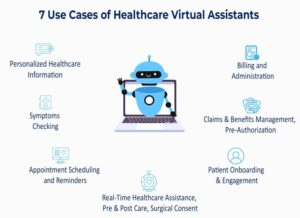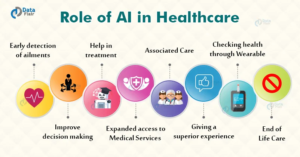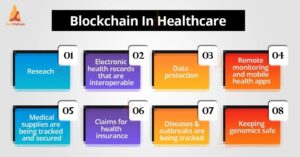
We are seeing new healthcare solutions emerge as a result of the convergence of IT technology and medical care. Adopting the right technologies makes it easier to implement the patient-centric approach.
Virtual Assistance

The demand for virtual healthcare is increasing all the time. It is critical for patient-centric providers to have all of the necessary tools to support various types of interactions with patients in addition to in-person appointments. The goal of virtual care is to provide patients with timely medical attention through telemedicine consultations, regular check-ins during treatment, remote health data monitoring, online treatment, and prescription adjustments. It entails both providing information and responding to questions from patients. For minor illnesses, virtual care can suffice. In general, it supplements healthcare experience and aids in providing consistent care for each patient.
Consultations on the Internet

Many patients and healthcare providers now use telemedicine. It consists of various communication channels that allow for real-time interaction and long-distance patient care. The remote diagnosis of patients can be facilitated through various telehealth solutions such as live video chats, instant messaging, mobile apps, and other communication tools, the provision of medical advice and recommendations, the resolution of concerns, and the walking through of instructions. Patient Monitoring via the Internet Remote patient monitoring, also known as telemonitoring, is another way to support the patient-centric approach. It enables remote patient health data collection and tracking via wearable medical devices. RPM is an excellent choice for monitoring vital signs following surgery and observing medical conditions for outpatient care. Health Care on the Go The use of mobile health is important in patient-centred healthcare. The new generation highly prefers it due to the ease of accessing healthcare with a few taps. It provides health services, collects, manages, and communicates health data, and serves as an engagement and communication tool. PMS for Care Coordination A good practise management system for hospitals and clinics is a good starting point for a patient-centred approach. Aside from being entertaining, it solves coordination and related activity problems. PMS basic functionality includes:
The electronic health record system, on the other hand, allows for the storage of patient information such as allergies, disease codes, treatment plans, and lab results. It enables the exchange of patient information with specialists from various medical practises. Healthcare providers can benefit from the complete digitalisation of their services. This can be accomplished by using a PMS system to streamline workflows and integrating with an EHR solution to make it even more patient-centric. Interactions between Stores and Forwards Asynchronous communication is an effective method for administering and coordinating medical data. Data can be shared, acted on, and accessed by physicians in multiple locations thanks to store-and-forward. What are the difficulties in implementing a patient-centred approach? To begin, healthcare systems must gain physician support by ensuring that both doctors and their staff are adequately prepared and that appropriate expectations are set across the organisation. Patient-centric care may necessitate the use of resources not currently reimbursed by most health insurance plans, necessitating the modification of reimbursement policies.
Emerging Technologies for Improving Patient-Centred Approaches: Personal Medical Knowledge Making Use of AI

A personal medical experience is the joy of patient-centred healthcare. Detailed diagnostics and medical decisions can become more precise and specific for patients with the availability of AI and family health records. Prescription drugs, healthy diet advice, and allergy treatment will be more effective. A patient can also be warned in advance of genetically inherited illnesses and advised on how to avoid them. Deep structured learning for health decision-making is another practical application of AI and ML. AI consultations can provide diagnoses and detailed medical actions tailored to a specific patient based on millions of relevant case examples.
Blockchain

Unleashing the potential of blockchain technology can solve some of the most crucial issues in the healthcare industry. The use of blockchain will ensure:
For medical data, blockchain is a safe haven. A smart contract can be used to safeguard a patient’s medical information. Cloud Computing Services Cloud-based solutions have become the norm in modern software systems. It enables stakeholder interoperability and works well with remote work locations, uniting all branches of a healthcare system. Platforms that enable real-time communication and access to health records should be considered by hospitals and professional healthcare providers. Cloud-based systems and communication platforms allow quick and secure data collection, integration, and synchronisation. Data gathered from clinical, financial, and operational departments should create new quality, patient satisfaction, and healthcare performance metrics.
VR and AR Technology

Augmented and Virtual Reality are two other technologies that drive innovation in a patient-centric environment. We see a stable increase in the number of use cases where AR and VR solutions create new opportunities for healthcare providers. These technologies, for example, can assist patients in alleviating the symptoms of mental disorders such as depression or anxiety. On the other hand, doctors who use AR and VR solutions can improve treatment accuracy and speed up surgery. Digital and Data Analytics Opportunities for Patient Engagement Patients nowadays demand more personalised approaches to healthcare and expect a better experience. To assist in meeting these demands, digital tools and data analytics offer medical organisations numerous opportunities to address unmet patient needs. Digital technologies enable patients to take control of their data, participate in decision-making, transform patient care, and rely on improved clinical outcomes. In this regard, patients are interested in implementing tools that will allow them to take an active role in their well-being. For example, they frequently use wearables, sensors, and mobile apps to promote a new level of connectivity between patients and healthcare providers. It enables both parties to prevent diseases and achieve desired treatment outcomes. The Difficulties of Adopting a Patient-centred Approach Today, shifting to a patient-centric approach is more about shifting mindsets and cultures. The main issue is that current healthcare still operates in a provider-centric mode. The change means new experiences for everyone in the organisation, including healthcare professionals and administrative personnel. As a result, everyone should be prepared, well-trained, and have realistic expectations. Furthermore, adopting this approach frequently necessitates the adoption of new technologies. The Most Effective Approach to Patient-Centred Healthcare The patient-centric model can only be implemented with the use of technology. As a result, healthcare providers must consider the best technological solutions for making data-driven decisions, providing consistent medical care, and considering each patient’s unique characteristics. When combined with the appropriate tools, patients’ participation and contribution will result in an improved medical experience for patients, making patient-centric solutions the best adaptation for healthcare providers.
You will also like to read Virtual Skylights for Healthcare
©2024 Kryptonite SolutionsTM. All Rights Reserved.
Powered by: Purple Tuché